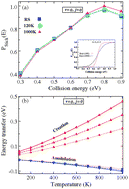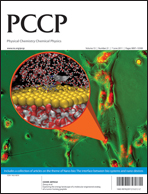The effect of phonon modes on the H2(v, j)/D2(v, j)–Cu(1nn) scattering processes†
Abstract
We include the effect of the phonon modes originating from the three layers of Cu(1nn) surface atoms on the dynamics of incoming molecular [H2(v, j)/D2(v, j)] degrees of freedom (DOFs) through a mean-field approach, where the surface temperature is incorporated into the effective potential by considering Bose–Einstein probability (BEP) factor for the initial state distribution of the surface modes calculated within harmonic approximation. Such time and temperature dependent effective Hamiltonian is further subdivided assuming a weak coupling between the two sets of molecular DOFs, namely, (x, y, z, Z) and (X, Y), respectively, in particular, to reduce the computational cost and the corresponding coupled quantum dynamical equations of motion have been formulated in terms of Time Dependent Discrete Variable Representation (TDDVR) approach. We demonstrate the workability of TDDVR method to investigate the scattering of H2(v, j) on Cu(1nn) surface by calculating the reaction probabilities and scattering cross-sections. Calculated results show that the phonon modes affect (a) the state-to-state transition probabilities of the scattered H2 molecule substantially but chemisorption and physisorption processes negligibly and (b) the reaction probability of the incoming D2 molecule noticeably.


 Please wait while we load your content...
Please wait while we load your content...